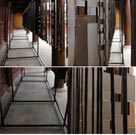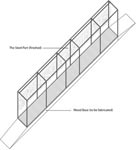Weiling He, an associate professor of architecture at Texas A&M, recently received university funding for her architectural installation, “The Cut,” to be shown as part of a 2008 traveling exhibition, “Elements,” featuring the work of U.S. and Greek architecture teachers.
She was one of 21 Texas A&M faculty members to receive funding through the 2007 Program to Enhance Scholarly and Creative Activities offered by the university’s Office of the Vice President for Research.
“The Cut,” He’s architectural interpretation of the poem, “France is Far,” by John Hejduk, is intended to demonstrate ways in which a visual work can interpret a non-visual work via a modified spatial experience.
“The Cut,” He explained, “intends to foreground the sentiment of discontinuity, interruption and fragmentation by creating spatial conditions that immediately challenge the viewer’s body.”
The installation will consist of 75 steel panels with rectangular holes in the sides. The panels, painted black and hung vertically from a steel structure, create a 25-foot long corridor that is seven feet high and 32 inches wide.
For He’s installation, Michael Jenks, a California College of the Arts student, created a digital music composition to the rhythm of Hejduk’s poem. The composition is divided into six segments and played consecutively from six speakers installed throughout the installation’s passageway.
He and other participants in the “Elements” exhibition have long been involved in an interdisciplinary study of the formation of intrinsic meaning in architecture.
| |

"
The Cut", He's architectural interpretation of the poem, "France is Far," by John Hejduk, is intended to demonstarte ways in which a visual work can interpret a non-visual work via a modified spatial experience

Larger images>>
|


